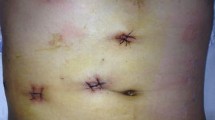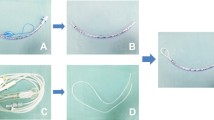Abstract
Background
To investigate the efficacy and safety of adding continuous occlusion of hepatic artery proper to intermittent Pringle maneuver in partial hepatectomy for ruptured hepatocellular carcinoma.
Materials and Methods
This is a retrospective study on data that were prospectively collected and entered into a computer database. A total of 36 patients who underwent partial hepatectomy for ruptured HCC by adding continuous occlusion of hepatic artery proper to intermittent Pringle maneuver at a tertiary care university hospital were compared with a historical case-matched control group of 36 patients who received intermittent Pringle maneuver only.
Results
The patient characteristics were comparable for the 2 groups of patients. The mean hepatic artery occlusion time was 58 min (range 36–98 min). Intraoperative blood loss and blood transfusion rate in the study group were significantly lower than the control group (P < .001 and P = .004, respectively). There were no significant differences in the postoperative serum aspartate transaminase and total bilirubin levels (P = .087, P = .135, respectively), and in the postoperative hospital stay and surgical complications according to Clavien’s classification between the two groups (P = 0.213, P = 1.000, respectively). The disease-free survival rates in the study group was significantly better than the control group (P = .023). Overall, HCC patients with rupture had poor prognosis.
Conclusions
The addition of continuous occlusion of hepatic artery proper to intermittent Pringle maneuver significantly reduced intraoperative blood loss for partial hepatectomy in patients with ruptured HCC when compared with intermittent Pringle maneuver alone. The procedure was found to be safe even for patients with liver cirrhosis.



Similar content being viewed by others
References
Bosch FX, Ribes J, Diaz M, Cleries R. Primary liver cancer: worldwide incidence and trends. Gastroenterology. 2004;127:S5–6.
Clavien PA, Petrowsky H, DeOliveira ML, Graf R. Strategies for safer liver surgery and partial liver transplantation. N Engl J Med. 2007;356:1545–59.
Lai ECH, Lau WY. Spontaneous rupture of hepatocellular carcinoma: a systematic review. Arch Surg. 2006;141:191–8.
Liu CL, Fan ST, Lo CM, Ng IO, Poon RT, Wong J. Intraoperative iatrogenic rupture of hepatocellular carcinoma. World J Surg. 2002;26:348–52.
Wayne JD, Lauwers GY, Ikai I, Doherty DA, Belghiti J, Yamaoka Y, et al.: Preoperative predictors of survival after resection of small hepatocellular carcinomas. Ann Surg. 2002;235:722–30; discussion 721–30.
Yeh CN, Chen MF, Lee WC, Jeng LB. Prognostic factors of hepatic resection for hepatocellular carcinoma with cirrhosis: Univariate and multivariate analysis. J Surg Oncol. 2002;81:195–202.
Tsochatzis EA, Germani G, Burroughs AK. Transarterial chemoembolization, transarterial chemotherapy, and intra-arterial chemotherapy for hepatocellular carcinoma treatment. Semin Oncol. 2010;37:89–93.
Xia F, Lau WY, Qian C, Wang SG, Ma KS, Bie P. Surgical treatment of giant liver hemangiomas: enucleation with continuous occlusion of hepatic artery proper and intermittent Pringle maneuver. World J Surg. 2010;34:2162–7.
Clavien PA, Barkun J, de Oliveira ML, Vauthey JN, Dindo D, Schulick RD, et al. The Clavien-Dindo classification of surgical complications: five-year experience. Ann Surg. 2009;250:187–96.
Llovet JM, Burroughs A, Bruix J. Hepatocellular carcinoma. Lancet. 2003;362:1907–17.
Ong GB, Taw JL. Spontaneous rupture of hepatocellular carcinoma. BMJ. 1972;4:146–9.
Tanaka A, Takeda R, Mukaihara S, Hayakawa K, Shibata T, Itoh K, et al. Treatment of ruptured hepatocellular carcinoma. Int J Clin Oncol. 2001;6:291–5.
Cherqui D, Panis Y, Rotman N, Fagniez PL. Emergency liver resection for spontaneous rupture of hepatocellular carcinoma complicating cirrhosis. Br J Surg. 1993;80:747–9.
Chiappa A, Zbar A, Audisio RA, Paties C, Bertani E, Staudacher C. Emergency liver resection for ruptured hepatocellular carcinoma complicating cirrhosis. Hepatogastroenterology. 1999;46:1145–50.
Vergara V, Muratore A, Bouzari H, Polastri R, Ferrero A, Galatola G, et al. Spontaneous rupture of hepatocellular carcinoma: surgical resection and long-term survival. Eur J Surg Oncol. 2000;26:770–2.
Marini P, Vilgrain V, Belghiti J. Management of spontaneous rupture of liver tumours. Dig Surg. 2002;19:109–13.
Benson AB III, Abrams TA, Ben-Josef E, Bloomston PM, Botha JF, Clary BM, et al. NCCN clinical practice guidelines in oncology: Hepatobiliary cancers. J Natl Compr Canc Netw. 2009;7:350–91.
Chearanai O, Plengvanit U, Asavanich C, Damrongsak D, Sindhvananda K, Boonyapisit S. Spontaneous rupture of primary hepatoma: report of 63 cases with particular reference to the pathogenesis and rationale of treatment by hepatic artery ligation. Cancer. 1983;51:1532–6.
Lai ECS, Wu KM, Choi TK, Fan ST, Wong J. Spontaneous ruptured hepatocellular carcinoma: an appraisal of surgical treatment. Ann Surg. 1989;210:24–8.
Lesurtel M, Selzner M, Petrowsky H, McCormack L, Clavien PA. How should transection of the liver be performed? A prospective randomized study in 100 consecutive patients: comparing four different transection strategies. Ann Surg. 2005;242:814–22; discussion 822–3.
Poon RT, Fan ST, Lo CM, Ng IO, Liu CL, Lam CM, et al.: Improving survival results after resection of hepatocellular carcinoma: A prospective study of 377 patients over 10 years. Ann Surg. 2001;234:63–70.
Kanematsu T, Furui J, Yanaga K, Okudaira S, Shimada M, Shirabe K. A 16-year experience in performing hepatic resection in 303 patients with hepatocellular carcinoma: 1985–2000. Surgery. 2002;131:S153–8.
Zhu LX, Meng XL, Fan ST. Elasticity of small artery in patient with spontaneous rupture of hepatocellular carcinoma. Hepatol Res. 2004;29:13–7.
Imamura H, Seyama Y, Kokudo N, Maema A, Sugawara Y, Sano K, et al.: One thousand fifty-six hepatectomies without mortality in 8 years. Arch Surg. 2003;138:1198–206; discussion 1206.
Liu CL, Fan ST, Lo CM, Tso WK, Poon RT, Lam CM, et al. Management of spontaneous rupture of hepatocellular carcinoma: single-center experience. J Clin Oncol. 2001;19:3725–32.
Yeh CN, Lee WC, Jeng LB, Chen MF, Yu MC. Spontaneous tumour rupture and prognosis in patients with hepatocellular carcinoma. Br J Surg. 2002;89:1125–9.
Mizuno S, Yamagiwa K, Ogawa T, Tabata M, Yokoi H, Isaji S, et al. Are the results of surgical treatment of hepatocellular carcinoma poor if the tumor has spontaneously ruptured? Scand J Gastroenterol. 2004;39:567–70.
Acknowledgment
We are grateful to Miss Zhongfang Jie, a research assistant, for her help with data collection and statistical analyses. This work was supported by the National S&T Major Project (NO. 2008ZX10002-026).
Author information
Authors and Affiliations
Corresponding author
Rights and permissions
About this article
Cite this article
Xia, F., Lau, WY., Qian, C. et al. Continuous Occlusion of Hepatic Artery Proper for Prevention of Blood Loss in Partial Hepatectomy for Ruptured Hepatocellular Carcinoma: A Case-Matched Comparative Study. Ann Surg Oncol 18, 1638–1643 (2011). https://doi.org/10.1245/s10434-010-1484-3
Received:
Published:
Issue Date:
DOI: https://doi.org/10.1245/s10434-010-1484-3




